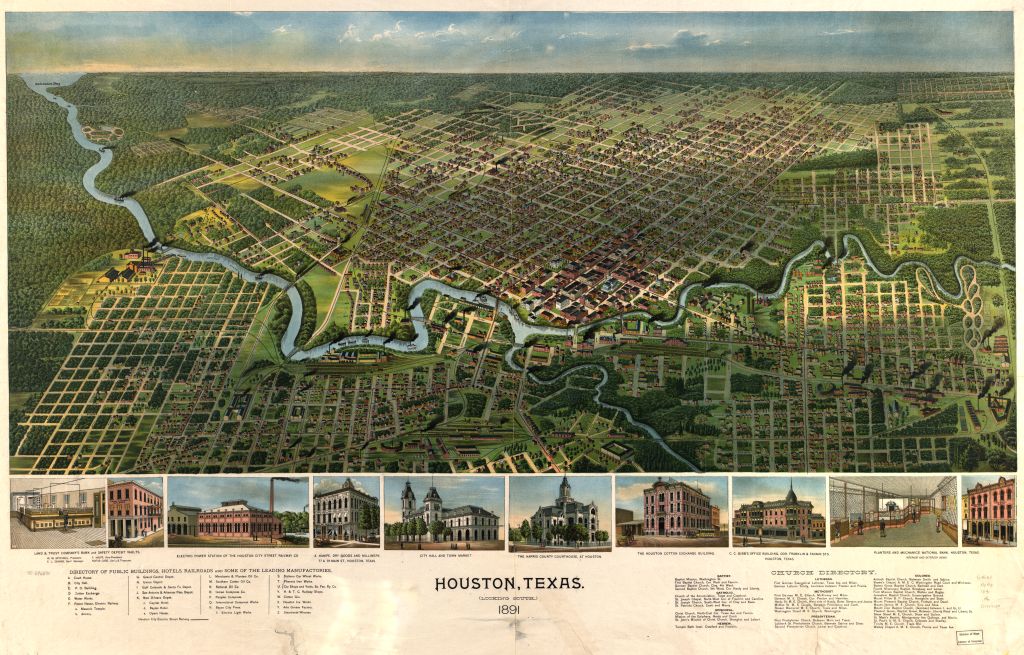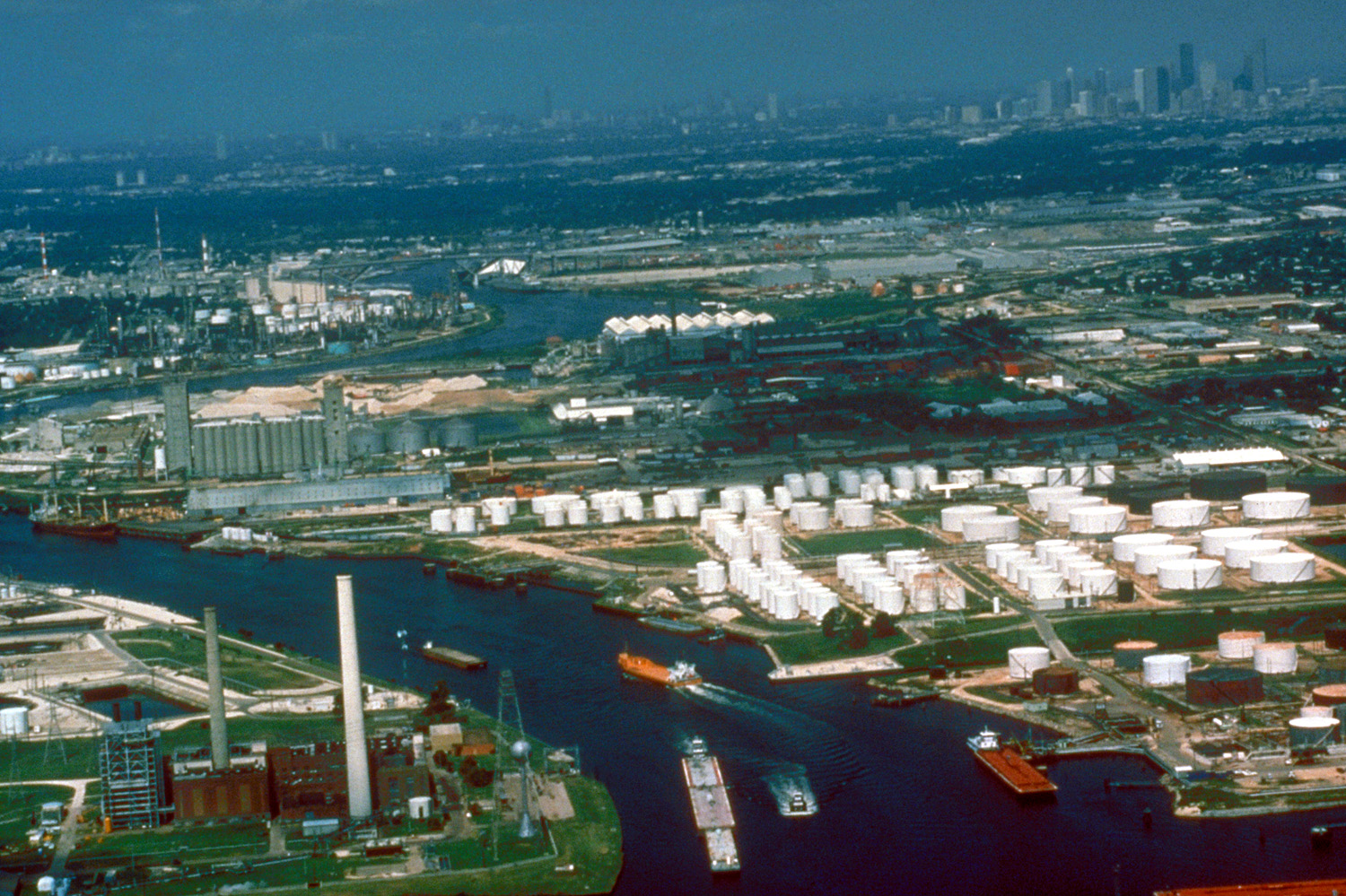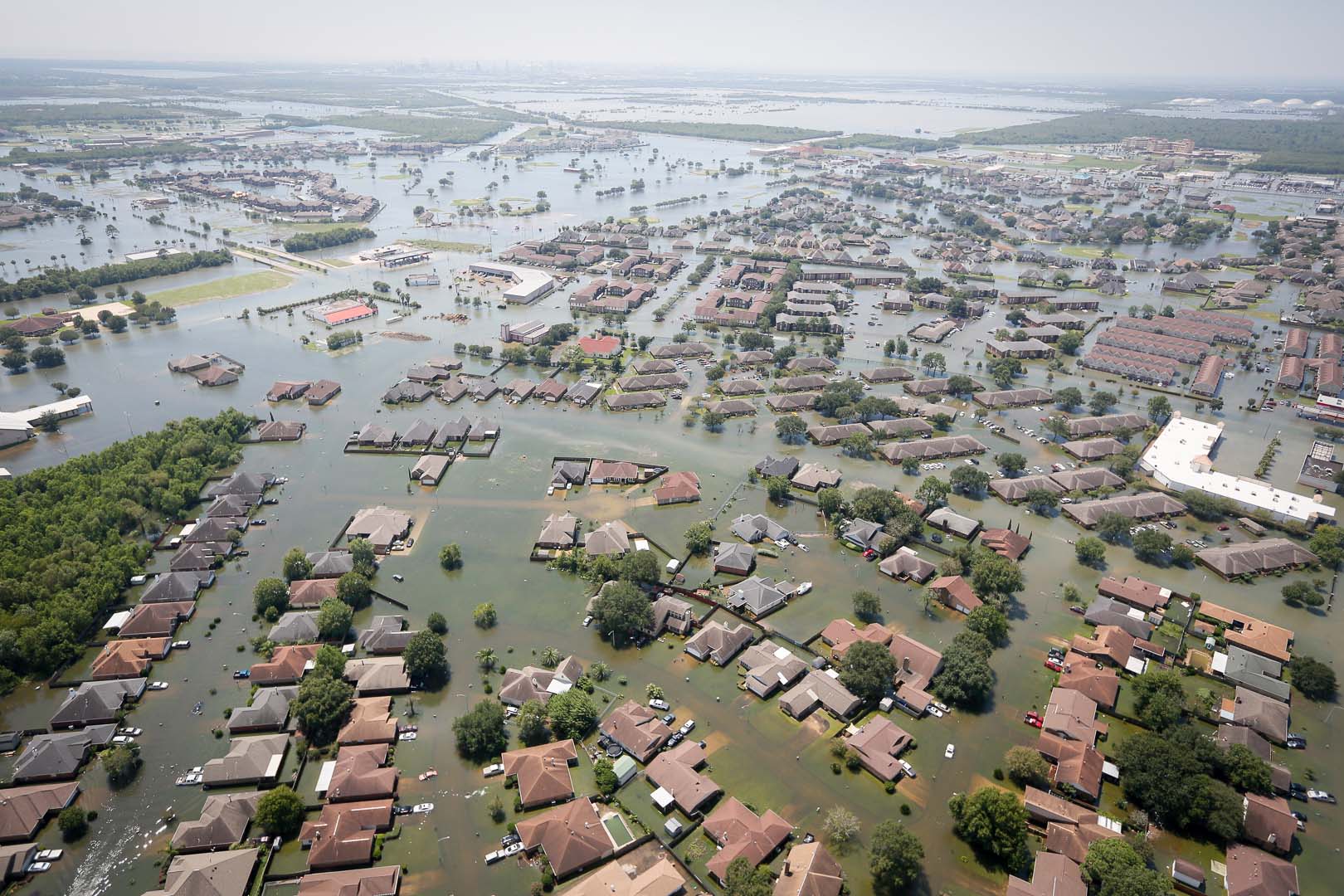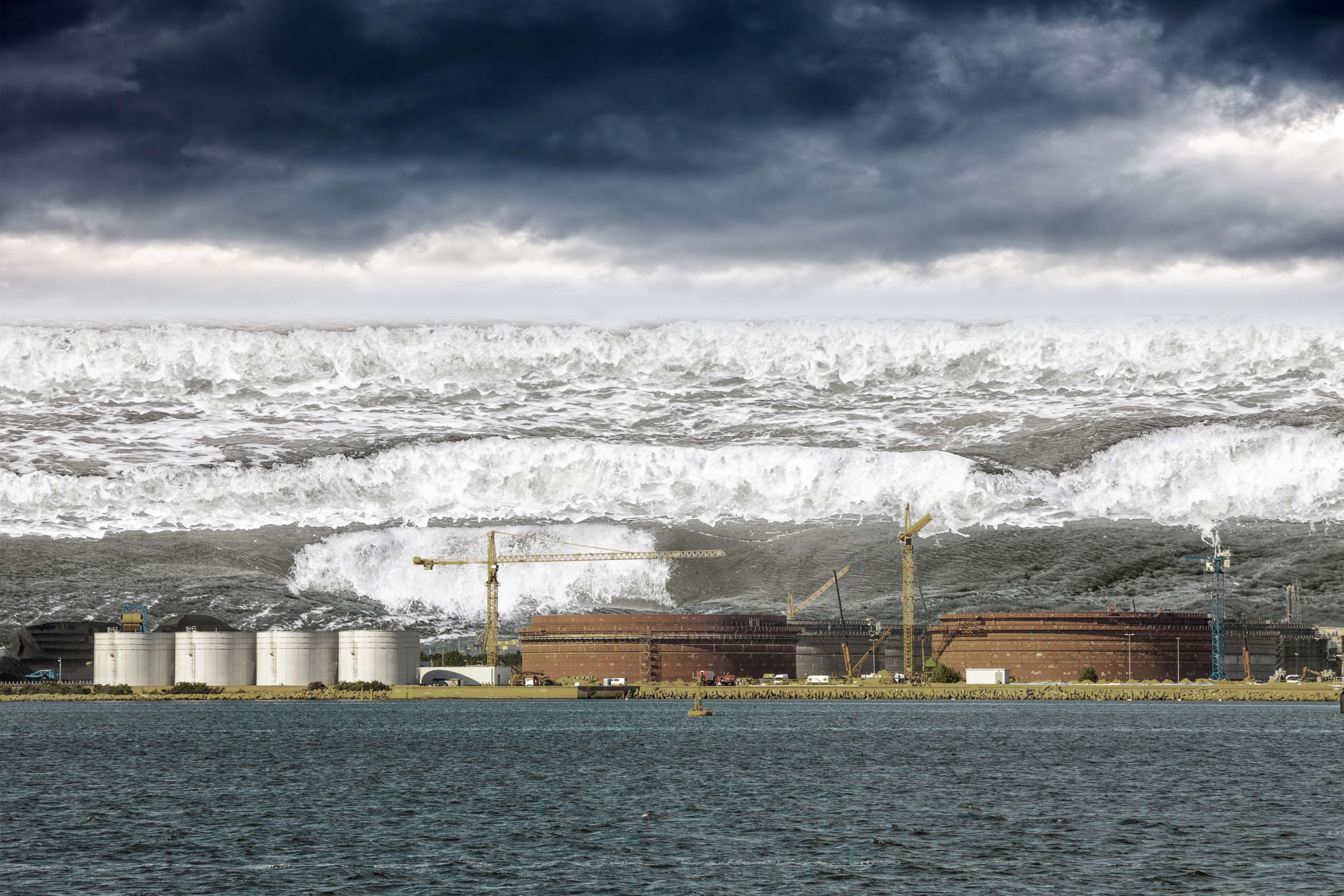The recent flooding in Houston, Texas, caused by Hurricane Harvey, underscores the need for citizens, politicians, and planners alike to conceive of water not only as a shared resource but also, with climate change, a collective risk that requires a collective response for port, city, and hinterland. We need socially responsible ways to respond to disasters, because neither individual citizens nor communities will be able to withstand the enormous changes produced by global water rise. In particular, the storm’s damage to the industrial spaces of oil has been a warning call.
 In 1891, before the discovery of the Corsicana oil field, the winding and swampy Buffalo Bayou was the spine of the city. Oil companies were scarce, and located along the Bayou and along railroads (Library of Congress:
https://tile.loc.gov/imageservices/iiif/service:gmd:gmd403:g4034:g4034h:pm009150/full/pct:12.5/0/default.jpg)
In 1891, before the discovery of the Corsicana oil field, the winding and swampy Buffalo Bayou was the spine of the city. Oil companies were scarce, and located along the Bayou and along railroads (Library of Congress:
https://tile.loc.gov/imageservices/iiif/service:gmd:gmd403:g4034:g4034h:pm009150/full/pct:12.5/0/default.jpg)
Houston has long claimed the title “Energy Capital of the World” and has long been a hub for the petrochemical industry, which often locates its facilities in port cities and near water.
The city grew exponentially thanks to the connection between water and oil [1]. As a port city close to the booming oil fields tapped in the early 20th century, Houston has facilitated multiple functions (previous image). People came together to redesign waterways and water-land transitions to facilitate the flow of goods and people; water took on an industrial role. Often the focus was on improving speed and logistics (and sometimes safety). In Houston’s Harris Country, citizens came together in 1909 to form a “navigation district” (an autonomous governmental body to supervise the port) and to co-fund with the federal government a new shipping channel to give ships access to both the ocean and inland waterways. By the 1950s a variety of industries – including steel, rubber, concrete, and petrochemical lined the new channel, which Newsweek called the “Blood line of Industry” in 1954 [2].
This aerial view of the Houston Ship Channel on Buffalo Bayou shows petroleum storage tanks and industry in 1999 (Source: U.S. Army Corps of Engineers, https://en.wikipedia.org/wiki/Houston_Ship_Channel#/media/File:Houston_Ship_Channel_Galena.jpg)
Today, Houston is a place to work for millions of people associated with shipping, oil, and their supporting industries. The riches that came with these activities contributed to huge urban sprawl; because the city refrained from most zoning, housing districts arose next to industrial sites. The proliferation of streets and houses made the land impervious, forcing rainwater to accumulate on sealed off streets and other hard surfaces.
In August 2017, as Hurricane Harvey came ashore, the separation between water and land use disappeared. Water washed over areas demarcated for industry, administration, and housing; it damaged or destroyed buildings, cars, and oil infrastructure-refineries, storage tanks, and gas stations. Water flowed down highways and rail lines, piling up debris at port facilities and throughout the city. All of this challenged oil production lines and logistics; even pipelines that were not damaged had to shut down due to limited production [3]. Water weighed down or damaged the floating roofs of petroleum storage tanks, releasing millions of pounds of chemical pollutants into the air and water [4]. Flooding, on top of failure to meet safety standards, led to explosions in the Arkema chemical plant in nearby Crosby, Texas [5]. Water also washed chemicals from the grounds of industrial sites, including areas so toxic that they had qualified for the federal government Superfund cleanup program, into the streets and swamps [6].
Hurricane Harvey flooded entire neighborhoods, 31. August 2017, (U.S. Air National Guard photo by Staff Sgt. Daniel J. Martinez, https://en.wikipedia.org/wiki/Hurricane_Harvey#/media/File:Support_during_Hurricane_Harvey_(TX)_(50).jpg)
The long-term effects of the flooding are yet unclear. Pipelines in the ground may have
become unstable or broken. The extent to which wastewater overflows have polluted the residential district overall will probably take some time to determine, as will their differential effects on neighborhoods of different income groups. Activists and citizens have pointed particularly to the history of environmental racism shaping the impact of the storm on overwhelmingly Latino and black communities near toxic areas [7].
Meanwhile, cleaning up after the disaster will take a lot of public and private Investment that might well have been invested in preparatory planning. The history of the Houston navigation district shows that collective action can influence long-time urban development and economic growth. Similarly, collaboration is necessary to protect against large-scale flooding and sea-level rise. The long history of water control in the Netherlands, where large parts of the country are prone to sea and river flooding and where a quarter of the land lies below sea level, suggests that flood preparedness is best when it is based on collective action; the Dutch water boards are among the earliest democratic institutions world-wide and have maintained dykes and waterways, and controlled water quality since the 13th century.
We have long known the larger environmental challenges of oil sites-as one example of dangerous industries – literally since the beginning of the petrochemical industry. In 1865, a few years after the first successful drilling, the Philadelphia Inquirer spoke of “Petroleum Terror” [8]. Environmental considerations were an issue in cities from Philadelphia to Hamburg and Rotterdam in the 1860s and 70s, when companies sited early refineries upstream of the urban water supply. Refineries continue to be major sources of air, water, and soil pollution, releasing hazardous and toxic pollutants through both normal and accidental processes. Their location within growing (port) cities around the world, in the vicinity of millions of people, increases the chance for a major environmental disaster. Some have the finances and the knowledge to prepare for flooding; Tokyo, for example, has built huge water storage cisterns [9]. Other cities do not have the same resources, and it remains unclear whether more concrete structures can withstand changes in water heights produced by climate change. Bigger storms and the global rise of sea levels will further increase the conflicts between harmful industry and citizens. The Houston disaster demonstrates that a response to climate change must go beyond planning for specific zones, people, or goods.
Apocalyptic scene of tsunami threatening an oil refinery. (Source: ID 74829983 © Nightman1965 | Dreamstime)
The American planning historian Larry Vale introduced the concept of critical resilience, arguing that planning needs to be more attuned to issues of power and politics in moments of disaster and after [10]. The Dutch planner Han Meyer has made the case that it is no longer feasible for countries and cities to deny that water is rising and the climate is change; he calls for planning for resilience [11]. As Meyer suggests, delta regions, where people have historically congregated and where economic development is concentrated, are also the areas most at risk. Spatial planning must address the spaces where sea and land, port and city, goods and people meet and must acknowledge how water connects seemingly disparate functions, spaces, and times. This means that we need planners trained to create resilient institutions and spaces. We also need to overcome land-based, land-biased approaches to planning. Rather than specialists from many disciplines working separately, we need scholars and cities to work together on integrated planning of water and city of port and waterfront.
New large data sets, or big data, may help politicians, scientists, and citizens respond to disasters faster and in better-integrated and more socially responsible ways, as a recent data collection event (a “hack-a-thon”) at TU Delft seems to suggest [12]. Connecting and correlating different data sets for example, on existing infrastructure and building types and on income or education levels may help first responders, policy makers, or planners target the most distressed communities for support after a disaster such as Hurricane Maria in Puerto Rico, and, even better, to identify places most at risk and to develop effective long-term strategies to prepare for climate change.
Notes
[1] Carola Hein, “Between Oil and Water: The Logistical Petroleumscape,” in The Petropolis of Tomorrow, ed. Neeraj Bhatia and Mary Casper (New York: Actar / Architecture at Rice, 2013).
[2] “Greater Houston: Its First Million People-and Why,” Newsweek, July 5 1954.
[3] Clifford Krauss, “Storm’s Impact on Oil Industry Is Felt at Gasoline Pumps,” New York Times.
[4] Nsikan Akpan, “Hurricane Harvey Damages Petrochemical Refineries, Releasing Thousands of Pounds of Airborne Pollutants,” PBS Newshour,
[5] Julie Turkewitz, Henry Fountain, and Hiroko Tabuchi, “New Hazard in Storm Zone: Chemical Blasts and ‘Noxious’ Smoke,”
https://www.nytimes.com/2017/08/31/us/texas-chemical-plant-explosion-arkema.html.
[6] Troy Griggs et al., “More Than 40 Sites Released Hazardous Pollutants Because of Hurricane Harvey,” New York Times.
[7] Oliver Milman, “Your Eyes Start Itching’: Pollution Soars in Houston after Chemical Industry Leaks.”
[8] “The Petroleum Terror. The Amount of Oil in the City the Possibility of a Philadelphia Disaster Necessity of Legislative Action Where Petroleum Is Stored.,” New York Times (1865).
[9] Hiroko Tabuchi, “Tokyo Is Preparing for Floods ‘Beyond Anything We’ve Seen’,” ibid. (2017).
[10] Lawrence Vale, ed. Towards Critical Resilience: Learning from the History of Post-Trauma Urbanism, vol. 2, International Planning History Society Proceedings (Delft: BK Books, 2016).
[11] Han Meyer, “Making Urbanizing Deltas More Resilient by Design,” ibid., ed. Carola Hein.
[12] Harvey Hackathon: Data collection Event,
https://www.tudelft.nl/evenementen/2017/citg/citg/harvey-hackathon-data-collection-event/ (last accessed 20 October 2017)
References
Akpan, Nsikan. “Hurricane Harvey Damages Petrochemical Refineries, Releasing Thousands of Pounds of Airborne Pollutants.” PBS Newshour
“Greater Houston: Its First Million People-and Why.”Newsweek, July 5 1954, 38-45.
Griggs, Troy, Andrew W. Lehren, Nadja Popovich, Anjali Singhvi, and Hiroko Tabuchi. “More Than 40 Sites Released Hazardous Pollutants Because of Hurricane Harvey.” New York Times
https://www.nytimes.com/interactive/2017/09/08/us/houston-hurricane-harvey-harzardous-chemicals.html
Hein, Carola. “Between Oil and Water: The Logistical Petroleumscape.” In The Petropolis of Tomorrow, edited by Neeraj Bhatia and Mary Casper, 436-47. New York: Actar / Architecture at Rice, 2013.
Krauss, Clifford. “Storm’s Impact on Oil Industry Is Felt at Gasoline Pumps.” New York Times.
Meyer, Han. “Making Urbanizing Deltas More Resilient by Design.” In International Planning History Society Proceedings, edited by Carola Hein, 13-24. Delft: BK Books, 2016.
Milman, Oliver. “‘Your Eyes Start Itching’: Pollution Soars in Houston after Chemical Industry Leaks.”
“The Petroleum Terror. The Amount of Oil in the City the Possibility of a Philadelphia Disaster Necessity of Legislative Action Where Petroleum Is Stored.”. New York Times (February 12 1865).
Tabuchi, Hiroko. “Tokyo Is Preparing for Floods ‘Beyond Anything We’ve Seen’.” New York Times (October 6 2017).
Turkewitz, Julie, Henry Fountain, and Hiroko Tabuchi. “New Hazard in Storm Zone: Chemical Blasts and ‘Noxious’ Smoke.”
https://www.nytimes.com/2017/08/31/us/texas-chemical-plant-explosion-arkema.html
Vale, Lawrence, ed. Towards Critical Resilience: Learning from the History of Post-Trauma Urbanism. Edited by Carola Hein Vol. 2, International Planning History Society Proceedings. Delft: BK Books, 2016.


